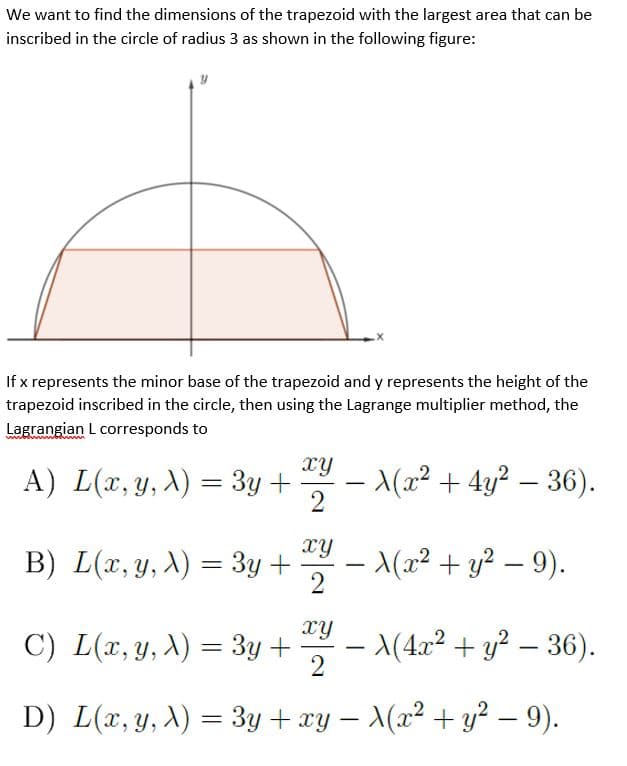We want to find the dimensions of the trapezoid with the largest area that can be inscribed in the circle of radius 3 as shown in the following figure: If x represents the minor base of the trapezoid and y represents the height of the trapezoid inscribed in the circle, then using the Lagrange multiplier method, the Lagrangian L corresponds to xy A) L(x,y, X) = 3y + - (x² + 4y² – 36). 2 - |
We want to find the dimensions of the trapezoid with the largest area that can be inscribed in the circle of radius 3 as shown in the following figure: If x represents the minor base of the trapezoid and y represents the height of the trapezoid inscribed in the circle, then using the Lagrange multiplier method, the Lagrangian L corresponds to xy A) L(x,y, X) = 3y + - (x² + 4y² – 36). 2 - |
Algebra & Trigonometry with Analytic Geometry
13th Edition
ISBN:9781133382119
Author:Swokowski
Publisher:Swokowski
Chapter9: Systems Of Equations And Inequalities
Section: Chapter Questions
Problem 12T
Related questions
Question

Transcribed Image Text:We want to find the dimensions of the trapezoid with the largest area that can be
inscribed in the circle of radius 3 as shown in the following figure:
If x represents the minor base of the trapezoid and y represents the height of the
trapezoid inscribed in the circle, then using the Lagrange multiplier method, the
Lagrangian L corresponds to
xy
A) L(x, y, A) = 3y +
- (x² + 4y² – 36).
2
-
xy
B) L(x, y, X) = 3y +
(x² + y² – 9).
-
xy
C) L(x, y, X) = 3y +
– (4x² + y² – 36).
2
D) L(x, y, A) = 3y + xy – \(x² + y² – 9).
Expert Solution
This question has been solved!
Explore an expertly crafted, step-by-step solution for a thorough understanding of key concepts.
Step by step
Solved in 2 steps with 1 images

Recommended textbooks for you

Algebra & Trigonometry with Analytic Geometry
Algebra
ISBN:
9781133382119
Author:
Swokowski
Publisher:
Cengage

Algebra & Trigonometry with Analytic Geometry
Algebra
ISBN:
9781133382119
Author:
Swokowski
Publisher:
Cengage